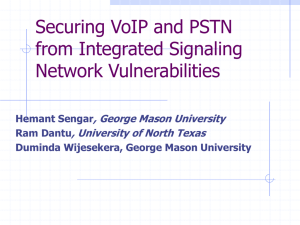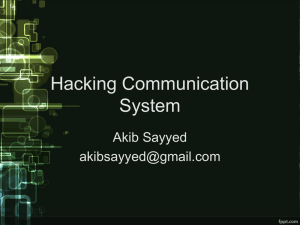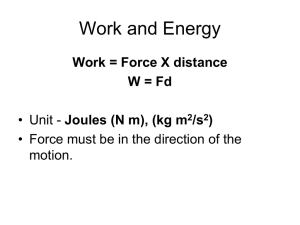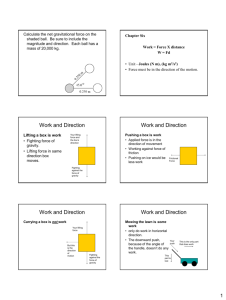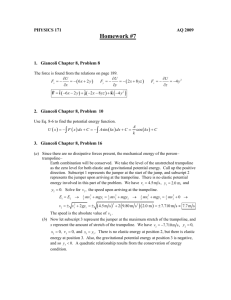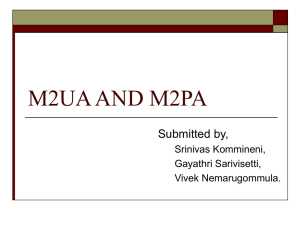GSM : The Network Layer
advertisement
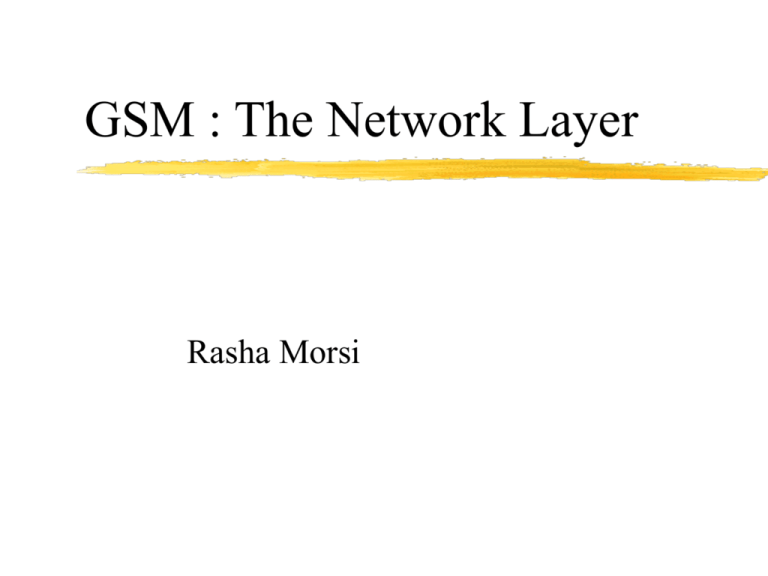
GSM : The Network Layer Rasha Morsi Presentation Outline: Radio Resource Management Mobility Management Call Control Management Layer 3 Protocols Mobile Application Part protocol Flow chart of initial mobile acquisition Mobile originating call procedure Structure of a layer 3 message Why GSM? Acronyms: TMSI : Temporary Mobile Subscriber Identity IMSI : International Mobile Subscriber Identity BCCH : Broadcast Control Channel FCCH : Frequency Correction Channel SCH : Synchronization Channel RACH : Random Access Channel AGCH :Access Grant Channel SDCH : Stand-alone Dedicated Control Channel SABM: Set Asynchronous Balanced Mode Acronyms (cnt’d) RIL3 : Radio Interface Layer 3 MAP : Mobile Application Part UA : Unnumbered Acknowledge TUP : Telephone User Part ISUP : ISDN User Part TCH : Tariff Channel ACCH: Associated Control Channel BSSMAP : BSS Management Part SCCP : Signaling Connection Control Part Air (Um) Interface A-bis Interface CCM RIL3 - CC MM RR RIL3 - MM RIL3 - RR DATP RSM A B C,D HLR/AuC MAP/D BSSMAP Distribution Protocol MAP/C MAP/E MAP/G TUP, ISUP O S I Component Sublayer TCAP Transaction Sublayer L A Y E R S Presentation Layer * Session Layer * Transport Layer * Network Layer Data Link Physical SCCP SCCP SCCP SCCP MTP3 MTP3 MTP3 MTP3 MTP3 MTP2 MTP2 MTP2 MTP1 MTP1 MTP1 LAP-D LAP-D MTP2 MTP2 Radio 64kbps ch MTP1 MTP1 Radio Resource Management sublayer: Tasks closely related to physical layer management of frequency spectrum everything to do with maintaining a clear channel between PLMN and MS Handles all procedures necessary to establish, maintain and release dedicated radio channels Procedures in RR layer: Channel assignment Channel release Channel change and handover Change of channel frequencies, hopping sequences (algorithms) and frequency tables Measurement reports from the MS Power control and Time advance Modification of channel modes (speech and data) Cipher mode setting Mobility Management sublayer: Cope with all effects of handling a mobile user that are not directly related to radio functions. Support of user mobility, registration, and management of mobility data checking user and equipment identity user allowed to use services ? Extra services allowed ? Support user confidentiality ( register user under a TMSI) Provision of user security Provision of an MM connection, based on existing RR connection, to the CM sublayer Procedures in MM sublayer : Location Update Periodic updating Authentication procedure IMSI attach procedure (on power up a MS will present its IMSI to network and get a TMSI) IMSI detach ( on power off of a MS, detach procedure to tell network it is no longer in service. TMSI reallocation Identification Call Control sublayer: Manages all functions necessary for circuit-switched call control in GSM PLMN includes several protocol entities e.g. CC itself, SS, and SMS. CC entity includes control functions defined for ISDN network signaling, messages and procedures required for call establishment, call clearing call information etc. Procedures in CC sublayer: Call establishment for mobile-originated calls Call establishment for mobile-terminated calls Changes of transmission mode during an ongoing call ( incall modification) Call reestablishment after interruption of an MM connection Dual-tone multifrequency (DTMF) control procedure for DTMF transmission Air (Um) Interface A-bis Interface CCM RIL3 - CC MM RR RIL3 - MM RIL3 - RR DATP RSM A B C,D HLR/AuC MAP/D BSSMAP Distribution Protocol MAP/C MAP/E MAP/G TUP, ISUP O S I Component Sublayer TCAP Transaction Sublayer L A Y E R S Presentation Layer * Session Layer * Transport Layer * Network Layer Data Link Physical SCCP SCCP SCCP SCCP MTP3 MTP3 MTP3 MTP3 MTP3 MTP2 MTP2 MTP2 MTP1 MTP1 MTP1 LAP-D LAP-D MTP2 MTP2 Radio 64kbps ch MTP1 MTP1 Layer 3 Protocols: RIL3-RR : establish and release radio connections between an MS and various BSCs for the duration of a call despite user movements. Provide system information broadcasting provide inter- and intracell change of channels provides ciphering mode setting Radio Subsystem Management ( RSM ): provides RR functions between BTS and BSC Direct Transfer Application Part ( DTAP ): provide RR messages between MS and MSC BSSMAP : provides RR messages between BSC and MSC Distribution Protocol : distinguishes between BSSMAP and DTAP RIL3-MM : deals with MS location management location updating IMSI attach periodic updating security aspects of system authentication TMSI reallocation identification. RIL3-CC : deals with mobile originating and terminating call establishment SS SMS All MM and CC functions reside in MSC. All CC and MM messages are not interpreted by either the BTS or BSC. An RR connection needs to be established before communication between MS and MSC can occur. Air (Um) Interface A-bis Interface CCM RIL3 - CC MM RR RIL3 - MM RIL3 - RR DATP RSM A B C,D HLR/AuC MAP/D BSSMAP Distribution Protocol MAP/C MAP/E MAP/G TUP, ISUP O S I Component Sublayer TCAP Transaction Sublayer L A Y E R S Presentation Layer * Session Layer * Transport Layer * Network Layer Data Link Physical SCCP SCCP SCCP SCCP MTP3 MTP3 MTP3 MTP3 MTP3 MTP2 MTP2 MTP2 MTP1 MTP1 MTP1 LAP-D LAP-D MTP2 MTP2 Radio 64kbps ch MTP1 MTP1 Transaction Capabilities Application Part (TCAP) : provides correlation between individual operations and structured exchanges building up a complete transaction. Transaction sublayer : manages transactions on an end-to-end basis. Component sublayer : correlates commands and responses within a dialog. MAP Protocol : Handles non-call related signaling between different network parts designed to interact with MSC, VLR/HLR, AUC, and GMSC so they can communicate with each other. Query - response contains a number of Application System Elements (ASE) all messages contain either mandatory or optional application parameters. Functions can be grouped into two categories: MM and basic service support. MAP Protocol Connections : RIL3 BSSMAP MAP/F MSC EIR MAP/B VLR MAP/I MAP/D BSS HLR MAP/C MAP/E MAP/G MAP/C GMSC VLR MSC MAP/B MAP/H SMS Gateway MAP Communication between peerto-peer nodes : ASE 1 ASE1 MAP MAP ASE n TCAP ASE n TCAP Physical Connection Flow Chart of Initial Mobile Acquisition: Power on Select channel with highest RF level among control ch.s Scan channels, monitor RF levels Scan ch. For frequency correction burst (FCCH) Select ch. With next highest RF level from control list NO Is FCCH detected? YES Scan ch. For timing sync. Burst ( SCH ) NO NO From the ch data update the control ch list is SCH detected ? YES Read data from BCCH ch and determine if the ch is a control ch ( BCCH ) is the current BCCH incl. YES Camp on BCCH and start decoding Mobile Originating Call Procedure: MS Press send BSS MSC VLR RIL3-RR Ch. Request RACH RIL3-RR IMM SABM AGCH < identity of message > UA Service Request TMSI, Call Setup SDCH (Up.Lk) SDCH (Dn. Lk.) SDCH (Up. Lk.) Service Request TMSI, Call Setup MAP/B Service Request, TMSI, Call Setup Authentication, Ciphering, and TMSI assignment HLR/EIR/AUC PSTN/ISDN MS BSS MSC RIL3-CC Setup ( Call Information ) VLR HLR/EIR/AUC MAP/B Send Call setup information Call complete MAP/B RIL3-CC call Proceeding Subscriber Phone Rings RIL3-CC Assignment cmd RIL3-CC assign. SDCH (Up.Lk.) complete RIL3-CC assign complete TUP/ISUP Initial Address Message ( IAM ) TUP/ISUP Address Complete Message ( ACM ) RIL3-CC alerting TCH/ACCH PSTN/ISDN RIL3-CC connect Answer Message RIL3-CC Connect Ack. Conversation Starts “ TUP/ISUP Answer Signal” Structure of a layer 3 message: 8 7 6 5 4 3 2 1 Octet Address field 1 Control field 2 Length indicator field 3 Bit 8 TI flag 0 7 6 5 4 3 2 1 Protocol Discriminator TI Message Type 4 Information field CRC Layer 2 Format type B . . . 10 11 12 Information Elements “ mandatory ” Information Elements “ optional ” Structure of a GSM layer 3 message Octet Transaction Identifier ( TI ) : Used to distinguish between possible (multiple) parallel CC connections and between various transactions taking place over these simultaneous CC connections. TI not relevant for RR and MM connections ( coded “ 0000” ) TI flag : indicates originator of a CC message ‘0’ by originator and coded ‘1’ by its peer entity originator fills in TI value. Kept and serves as a label during transaction Protocol Discriminator ( PD ) Links layer 3 protocol to the entity the message is addressed to. Identifies 6 protocols Protocol RRM MM CC SMS SS Test procedure All other values reserved PD Binary 0110 0101 0011 1001 1011 1111 Message Type : MT indicates the function of layer 3 message. Uses lower 6 bits ( 64 possible message types) for a protocol type indicated by PD. MT is part of a set of messages in a protocol Bit 8 = 0 ( reserved ) Bit 7 = send sequence variable and may be used for MM and CC messages. Information Elements (IE): Depending on MT, may or may not have one or more IE Types of IE : Mandatory fixed length ( MF ) Mandatory variable length ( MV) Optional Fixed Length (OF) OV TI flag 0 Protocol Discriminator TI Message Type Information Elements “ mandatory ” Information Elements “ optional ” Structure of a GSM layer 3 message Why GSM ? Digital High audio quality and link integrity High spectral efficiency Identical system in all countries Intersystem Roaming High degree of flexibility ( open architecture that will allow new services to be introduced in the future. Economy in both sparsely and heavily populated areas Integration with ISDN Other security features SMS and use of facsimile features Easy to introduce the system Low-cost infrastructure References: GSM System Engineering, Asha Mehrotra, Artech House Publishers, 1997 An Introduction To GSM, Redl, Weber, Oliphant, Artech House Publishers, 1995
